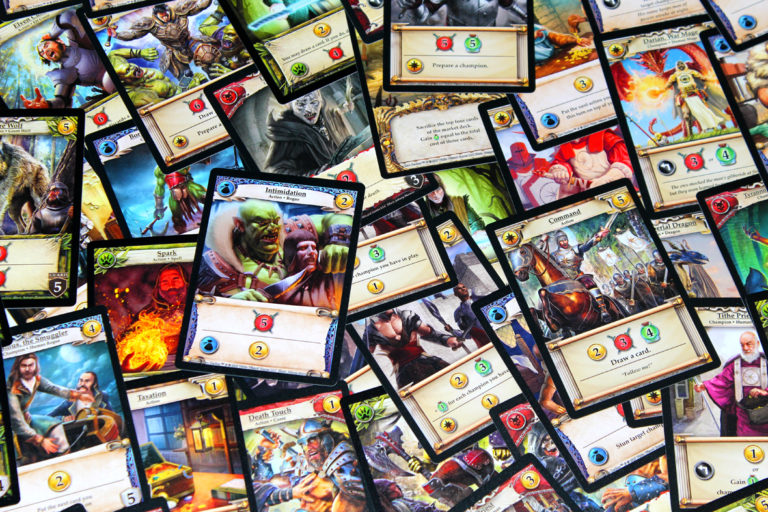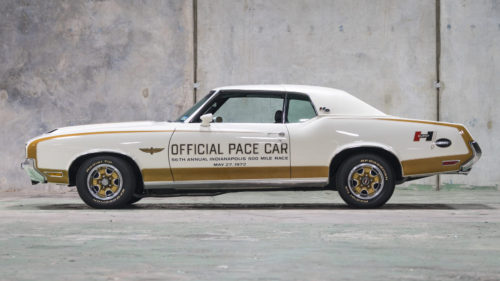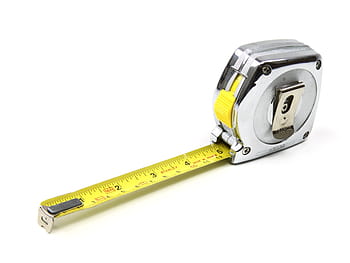In deck-building games there is a concept known as “decks.” Each deck is formed whenever you shuffle your discard pile and begin a new draw pile. This concept can help you to understand the relative value of mechanics like damage, defense, economy, and sacrifice at different stages of the game. This understanding is a key part of developing into a more advanced player.
Here are some ways in which understanding “decks” can affect how you play the game:
- Decks affect when you will be able to play the cards you purchase. Whenever you purchase a card, it goes into your discard pile (unless you can take advantage of a top-decking or to-hand ability). This means that the earliest you will normally be able to play the card you purchased will be in the next deck. Depending on when your next shuffle is, this can mean 1-6 turns from when you purchase a card until it will enter play.
- Decks dictate the number of times you get to play each card. Normally, you only get to play each card once per shuffle, unless you have an effect or ability that changes this (i.e. top-decking from your discard pile). The further along in the game you are, the less you will get to play each new card you purchase because it will be in fewer shuffles (and less “decks”) than ones you purchased earlier.
- Bottom Decking. If you trigger a shuffle while you have cards in hand or in play, those cards will not be included in the deck, which means they will essentially be “skipped” and you will play that card one fewer time during the course of the game. Since you must play all the cards in your hand, this is not always something you can control. The cards will be bottom-decked, and you are at the mercy of the shuffle (See this great article from Darklighter!). Sometimes the player will have the ability to choose when to trigger a shuffle and thus whether to bottom deck his cards in play or not. Recognizing and taking advantage of these opportunities can often be the difference in winning or losing a game.
- Analyzing how many turns and/or shuffles you need to win the game. Once your game plan has progressed and you have built a deck that synergizes, you can start to analyze how much time is left in the game. You can do this by adding how much damage you have left in your hand and draw pile to how much damage you have in your entire deck (including what you already counted). Subtract the defense and healing in your opponent’s deck. If the result is more than your opponent’s health, then you will be able to win within one more deck. If not, then you will need at least two more shuffles. If your opponent can do this faster than you, you will need to add more damage to your deck, or extend the game by adding defense or healing.
- The number of decks determines the value of each card over the course of a game. The more times you shuffle in a game, the more often you get to use each card, and the higher the cost performance of each card you play. A shorter game means that cost efficiency is less important than raw power. A longer game will have more shuffles, and will provide extra value for each card in your deck.
Decks and Game Pace
Hopefully the points above have already got you thinking about how keeping track of the pace of the game might affect your strategy. Economy cards and sacrifice are slow because they must be played twice (typically two “decks”) to have a significant effect, whereas combat has an immediate impact. Champions tend to slow down the game if your opponent is using their damage to stun them, but they can also speed up the game if your opponent lacks the ability to take them out (because they will make your successive hands stronger if they stay alive for multiple turns). Healing will slow down the game as well, giving the slower strategies time to fulminate. Draw and cycle effects will speed up whatever your deck is already doing. Remember that prioritizing cards you purchase to maximize your benefit from their primary effects is a key to winning. Understanding the pace of the game will make this easier to achieve.
There is no average length for a game of Hero Realms, at least not one that will help you precisely plan for every possible matchup. Which hero class you are playing and what your opponent is playing against you can change game length drastically. Some games end as early as turn 7, and some go past turn 50. At turn 50 the fatigue mechanic starts dealing unblockable damage that increases every turn, putting you on a timer to finish things off.
Even so, there are some basic stages that happen in every game of Hero Realms, though when exactly they start or stop is variable. There is the Opening, Midgame, and Endgame. Which part you are in will change what you need to focus on in order to grab the win
The Opening
- Class matchup and opening purchases will define your initial strategy. Knowing these matchups will help you to be able to plan for a slow game, fast game, or a mix of the two.
- Economy and sacrifice are better in the opening, as they will have more shuffles in which to do their work. These cards have a higher value if you know the game will go long.
- Damage has a higher value if you know the game will be short. Damage is okay to focus on, but if your opponent has lots of healing or champions you will fall behind if you don’t pivot to counter them.
- Make sure you have enough damage to take out your opponent’s champions. Leaving them out multiple turns will allow them to get extra value from them.
- In deck two, purchase cards that reinforce your initial strategy, or pivot your strategy if needed based on the market row and your opponent’s moves.
- If possible, try to time your reshuffles so that you can bottom deck the cards that do not help advance your game strategy. This can be applicable all game, but can have a huge impact to your plans in the opening.
The Mid-Game
- Lock in on your strategy; at this point it is harder to switch to a new one.
- Focus on buying powerful cards, otherwise buy the best cards that fit with your strategy. It is okay not to use all of your gold, it is so much better than buying cards that do not help you advance your strategy.
- Focus on buying damage if you’re ahead (or want to speed up the game) or champions/healing if you’re behind (or want to slow down the game).
- Economy and Sacrifice start to lose value. Only purchase more if they have other valuable effects or they will have a high chance to faction.
The End-Game
- Focus on purchasing cards that give you the most damage per draw. Cost efficiency is not important. You want big damage to finish the game, not more cards to slow down your deck.
- Stun is valuable if your opponent has champions.
- The only other cards you want to buy are ones that will help combo with cards you already have. Cards with draw or cycling effects are the exception as they do not slow down the pace of your deck.
- Make sure you have enough total damage in your deck to defeat your opponent before they can do the same to you. Otherwise buy champions or healing in order to extend the game until you do.
- Sometimes adding fire gems just before flipping your deck can help raise your damage output enough to finish your opponent off in the next deck when you wouldn’t be able to do so otherwise.
Game Length
The length of your game is essentially the amount of “defense” (initial hp + healing + champions) your opponent has remaining. This means that the length of the game is not the same for each player. If one player plays champions and/or heals, then she is making the game longer for her opponent but not for herself.
- In a shorter game, a “quick” (low cost, efficient) damage deck will accumulate the damage needed to win in fewer turns than a slower economy or sacrifice deck.
- In a longer game though, that slower economy or sacrifice will accumulate enough damage to win in fewer turns than a quick damage deck.
Short Game Considerations
Short game (or quick) strategies are focused on immediately accumulating damage and reducing the opponent’s health from the start, typically by buying damage cards as early and often as possible. Quick strategies will run a faster race the shorter the race is, as damage cards do not take two shuffles to start dealing damage. Damage cards are also less vulnerable to bad draws and bottom-decking because they accumulate damage immediately when they are played.
Purchasing champions can, somewhat surprisingly, also be a quick strategy. If the ones you purchase have the potential to generate recurring economy or damage early in the game when your opponent has little or no combat in her deck, it can quickly accelerate your own towards the finish line. Similarly, damage is also useful for keeping your opponent from doing this by eliminating his champions before they can generate recurring economy or damage. In a champion-heavy strategy, Varrick can also bring a games to a quick end if circumstances align.
Long Game Considerations
Long game (or slow) strategies are those which do not aim to immediately reduce your opponent’s health, but instead focus on buying economy cards and sacrifice. Long game strategies are slow to accumulate damage at first, but will accelerate non-linearly and increase exponentially the longer the game is.
Economy and sacrifice are only a means to accumulate more damage. They are not an end in itself. They are only valuable if they lead to more total damage than you would have gotten if you had just bought damage in the first place. Economy strategies can run into trouble if there is little or no damage available to buy when you play your economy cards. Similarly, sacrifice is only valuable if you also add damage cards into your deck along the way. The goal of economy is buying the expensive cards, those that accumulate damage the fastest by drawing (Domination, Fire Bomb, Rampage), top-decking (Deception, Smash and Grab), or staying out multiple turns (Arkus, Torgen, Grak) and are best for making up for the slow start of the game. Economy cards and sacrifice are also more sensitive to bad draws and bottom-decking because they require a shuffle before their effect can translate into damage (it means their beneficial effect is delayed one more shuffle).
This was the third part in a series discussing card types, deck archetypes, and game pace. If you haven’t read the others, I recommend you check them out as the reading order isn’t as important as understanding the concepts brought up in each article. The ideas can tie together in a gestalt manner to increase your understanding of Hero Realms better than just focusing on a single part.


